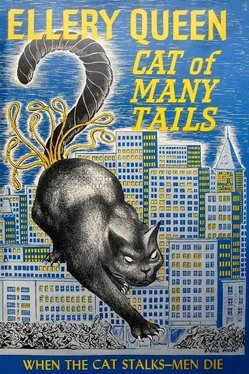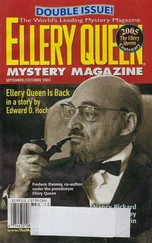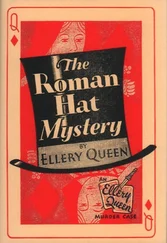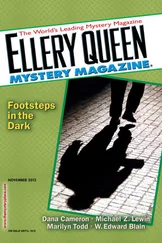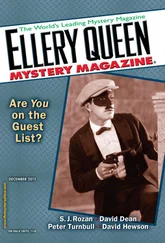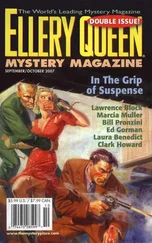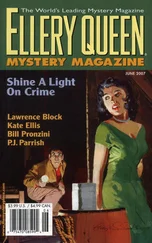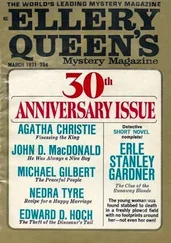“Fine job, McKell, just fine,” said the Inspector. “Night.”
“Keep in touch with me, Jimmy.”
“Mind if I drift in with Celeste tomorrow night?”
“Not in the least.”
“Thanks! Oh.” Jimmy paused in the foyer. “There’s one little thing.”
“What’s that?”
“Let me know when you clap him in irons, will you?”
When the door closed Ellery sprang to his feet.
His father poured another drink. “Here, have one.”
But Ellery mumbled, “That touch of so-called shell shock in the first war. Those recurring breakdowns. And in the middle age the obvious attempt to compensate for something in that sudden, apparently unprepared-for interest in psychiatry. It fits, it fits.”
“Drink it,” said his father.
“Then there’s the whole egocentric pattern. It’s unusual for a man of 50 to begin studying psychiatry, to set up in practice at 55, and to make a success of it to boot. His drive must be gigantic.
“Look at his early history. A man who set out to prove something to — whom? himself? society? And who wouldn’t let anything stand in his way. Who used every tool that came to hand and tossed it aside when it outlived its immediate usefulness. Professionally ethical always, but in the narrowest sense: I’m sure of it. And then marriage to a girl less than half his age — and not just any girl; it had to be a Merigrew of Maine.
“And those two tragic confinements, and... guilt. Guilt, decidedly: immediately that first breakdown. Overwork, yes; but not his body. His conscience.”
“Aren’t you doing an awful lot of guessing?” asked Inspector Queen.
“We’re not dealing with clues you can put on a slide. I wish I knew more!”
“You’re spilling it, son.”
“The conflicts set in, and from then on it’s a question of time. A gradual spreading of the warp. A sickening, a corruption of the whole psychic process — whatever the damned mechanism is. Somewhere along the line a personality that was merely paranoid in potential crossed over and became paranoid in fact. I wonder...”
“You wonder what?” asked his father when Ellery paused.
“I wonder if in either of those deliveries the infant died of strangulation.”
“Of what?”
“Umbilical. The umbilical cord wound around its neck.”
The old man stared.
Suddenly he bounced to his feet.
“Let’s go to bed.”
They found the white index card marked Abernethy, Sarah-Ann within twenty seconds of opening the file drawer labeled 1905-10. It was the eleventh card in the file. A blue card was clipped to it marked Abernethy, Archibald Dudley, m., b. May 24, 1905, 10:26 A.M.
There were two old-fashioned filing cabinets of walnut, each containing three drawers. Neither had locks, or catches, but the storage closet in which they found the cabinets had to be unlocked, a feat Sergeant Velie performed without difficulty. It was a large cabinet filled with the memorabilia and bric-a-brackery of the Cazalis household; but on the side where the cabinets stood were also a glass case of obstetrical and surgical instruments and a worn medical bag.
The records of his psychiatric practice were housed in modern steel cabinets in his inner office. These cabinets were locked.
The Queens, however, spent all their time in the crowded musty-smelling closet.
Mrs. Abernethy’s card recorded an ordinary case history of pregnancy. Archibald Dudley’s recorded the data of birth and infant development. It was evident that Dr. Cazalis had provided the customary pediatric care of the period.
Ninety-eight cards later he ran across one marked Smith, Eulalie to which was clipped a pink card marked Smith, Violette, f., b. Feb. 13, 1907, 6:55 P.M.
One hundred and sixty-four cards beyond the Smith cards they found the entries for O’Reilly, Maura B. and O’Reilly, Rian, m., b. Dec. 23, 1908, 4:36 A.M. Rian O’Reilly’s card was blue.
In less than an hour they located the cards of all nine of the Cat’s victims. There was no difficulty. They were arranged in chronological order in the drawers, each drawer was labeled with its year-sequence, and it was simply a matter of going through the drawers card by card.
Ellery sent Sergeant Velie for the Manhattan telephone directory. He spent some time with it.
“It’s so damnably logical,” complained Ellery, “once you have the key. We couldn’t understand why the Cat’s victims should be successively younger when there was no apparent connection among them. Obviously, Cazalis simply followed the chronology of his records. He went back to the beginning of his medical practice and systematically worked his way forward.”
“In forty-four years a lot had changed,” said the Inspector thoughtfully. “Patients had died off. Children he’d brought into the world had grown up and moved to other localities. And its nineteen years at a minimum since he had any medical contact with any of them. So most of these cards must be as obsolete as the dodo.”
“Exactly. Unless he was willing or prepared to undertake a complicated search, he couldn’t hope to make a clean sweep. So he’d tend to concentrate on the cards bearing names most easily traced. Since he’d had a Manhattan practice, the obvious reference was to the Manhattan phone book. Undoubtedly he began with the first card in his files. It’s Sylvan Sacopy, a boy born to a Margaret Sacopy in March of 1905. Well, neither name is to be found in the current Manhattan directory. So he went on to the second card. Again no luck. I’ve checked every name on the first ten listings and not one is to be found in the Manhattan book. Abernethy’s the first card with a current listing. And Abernethy was the first victim. And while I haven’t checked all the names on the ninety-seven cards between Abernethy and Violette Smith, I’ve taken enough of a sampling to indicate that Violette Smith became the Cat’s second victim for exactly the same reason: despite the fact that her card is Number 109, she had the misfortune to be Number 2 in the phone book checkback. There’s no doubt in my mind that the same thing is true of all the others.”
“We’ll check.”
“Then there was the baffling business of the non-marital status of all but one of the victims. Now that we know how Cazalis picked them, the answer is childishly clear. Of the nine victims, six were women and three were men. Of the three men, one was married and two were not — but Donald Katz was a youngster: it was a reasonable average. But of the six women not one was married. Why were the female victims consistently single? Because when a woman marries her name changes! The only women Cazalis could trace through the phone book were those whose names had remained the same as the names appearing on his case cards.
“And the curious color notes that ran through the crimes,” continued Ellery. “That was the most obvious clue of all, damn it. Blue cords for males, salmon-pink for females. Maybe it was the salmony cast of the pink that threw me off. But salmon is a shade of pink, and pink and blue are the traditional colors for infants.”
“It’s a sentimental touch,” muttered his father, “I could do without.”
“Sentimental nothing — it’s as significant as the color of hell. It indicates that deep in the chasm of his mind Cazalis regards his victims as infants still. When he strangled Abernethy with a blue cord he was really strangling a boy baby... using a cord to return him to limbo? The umbilical symbolism was there from the start. The murderous colors of childbirth.”
From somewhere in the apartment came the peaceful sounds of drawers opening.
“Velie,” said the Inspector. “God, if only some of these cords are here.”
Читать дальше
